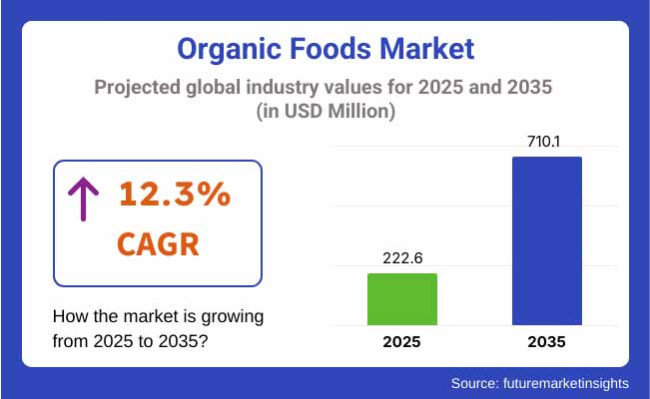Growing Season: The Supply Chain Path Behind Smart Soil Solutions – Food Manufacturing

Report on Technological Advancements in Agriculture and Their Contribution to Sustainable Development Goals
Introduction: The Intersection of Agriculture and Global Sustainability
Contemporary agricultural practices are increasingly leveraging innovative technology to address critical global challenges, including rising input costs, climate change, soil degradation, and water scarcity. The adoption of digital tools for farm management aligns directly with the United-Nations Sustainable Development Goals (SDGs), providing a pathway to enhance food security while promoting environmental stewardship. This report examines how precision agriculture, supported by a robust technological supply chain, contributes specifically to achieving these global objectives.
Precision Agriculture’s Role in Advancing the SDGs
Optimizing Resource Management for a Sustainable Future
Precision agriculture utilizes technology to optimize crop and livestock production, representing a significant shift towards more sustainable farming. This data-driven approach is critical for making progress on several key SDGs.
Contributions to Specific Sustainable Development Goals
- SDG 2: Zero Hunger: By using digital tools to monitor soil moisture, fertilizer application, and plant health, growers can significantly improve crop yields and profitability, contributing to global food security.
- SDG 6: Clean Water and Sanitation: Technology enables precise irrigation, minimizing water waste and agricultural runoff. This directly addresses water scarcity, a growing concern highlighted by the strain on major water sources like the Ogallala Aquifer.
- SDG 12: Responsible Consumption and Production: Precision application of inputs like water and fertilizer ensures resources are used efficiently, reducing waste and promoting sustainable production patterns.
- SDG 15: Life on Land: Monitoring soil nitrate levels and overall soil health helps prevent degradation, preserving the integrity of terrestrial ecosystems for future generations.
Case Study: AquaSpy and DigiKey’s Impact on Sustainable Farming
Technological Solutions for Soil and Water Intelligence
AquaSpy, a California-based agtech company, provides growers with smart soil solutions that exemplify the practical application of technology for sustainability. Their Crophesy system utilizes battery-powered probes with moisture sensors, allowing farmers to gather and analyze real-time soil profile data via a smartphone app. This empowers growers to make informed decisions that conserve resources. As AquaSpy’s Vice President of Engineering, Peter Ellegaard, states, “The only way you can change it is if you can measure it,” emphasizing the need for data in reversing soil and water depletion.
Recent innovations from AquaSpy include new probes with nitrate and oxygen sensors, providing near real-time data on soil health. This technology is crucial for managing input costs and directly supports SDG 15 (Life on Land) by enabling better soil management.
The Foundational Role of the Supply Chain in Agri-Tech Innovation
The development of these advanced agricultural devices relies on a resilient and accessible supply chain for electronic components. This highlights the importance of SDG 9: Industry, Innovation, and Infrastructure. DigiKey, a global distributor of electronic components, serves as a critical partner in this ecosystem.
- Component Accessibility: DigiKey supplies the essential components—sensors, communication modules, and hardware—that form the basis of IoT-enabled agricultural devices like those produced by AquaSpy.
- Facilitating Innovation: Tools such as DigiKey’s parametric search and cross-reference capabilities enable engineers like Ellegaard to efficiently find, compare, and procure components, accelerating the development cycle for new and improved sustainable technologies.
- Building Resilience: A reliable supply partner provides stability, allowing companies like AquaSpy to focus on innovation rather than sourcing challenges, thereby strengthening the entire infrastructure that supports sustainable agriculture.
Conclusion: A Collaborative Framework for Sustainable Agriculture
The advancement of sustainable agriculture is intrinsically linked to technological innovation and the industrial infrastructure that supports it. The collaboration between technology developers like AquaSpy and component suppliers like DigiKey demonstrates a powerful model for progress. By providing the tools to measure and manage critical resources, the agtech sector is making tangible contributions to achieving multiple Sustainable Development Goals, including Zero Hunger (SDG 2), Clean Water and Sanitation (SDG 6), Responsible Consumption and Production (SDG 12), and Life on Land (SDG 15). Continued investment in and support for this technological ecosystem is essential for building a resilient and sustainable future for global food production.
Analysis of Sustainable Development Goals in the Article
1. Which SDGs are addressed or connected to the issues highlighted in the article?
The article discusses several issues that directly connect to the following Sustainable Development Goals (SDGs):
- SDG 2: Zero Hunger: The core theme is improving agricultural practices to enhance food production. The article states that growers use technology to “improve their crop yield and build profitability,” which is central to ending hunger, achieving food security, and promoting sustainable agriculture.
- SDG 6: Clean Water and Sanitation: A significant portion of the article is dedicated to water management. It explicitly mentions “water scarcity,” the need to “optimize irrigation, minimize runoff and conserve water,” and the problem of draining aquifers like the Ogallala Aquifer. This directly aligns with ensuring the availability and sustainable management of water.
- SDG 9: Industry, Innovation, and Infrastructure: The article is fundamentally about technological innovation in the agricultural sector. It details the use of “innovative technology,” “digital tools and applications,” “sensors, automation systems, software and hardware,” and “IoT-enabled agricultural devices” to create more efficient and sustainable farming systems.
- SDG 12: Responsible Consumption and Production: The article highlights the need for more efficient use of resources in agriculture. By using technology to monitor “fertilizer applications” and “soil nitrate levels,” growers can reduce waste and ensure resources are used sustainably, which is a key aspect of responsible production patterns.
- SDG 13: Climate Action: The article opens by stating that growers are using technology to “combat rising issues related to… climate change.” This shows a direct link to taking action to combat climate change and its impacts by making agriculture more resilient.
- SDG 15: Life on Land: The article addresses the issue of “soil degradation” and the importance of maintaining “soil health.” The technologies discussed, such as soil moisture and nitrate sensors, are designed to protect and restore terrestrial ecosystems by preventing the degradation of agricultural land.
2. What specific targets under those SDGs can be identified based on the article’s content?
Based on the article’s focus, the following specific SDG targets can be identified:
- Target 2.4: By 2030, ensure sustainable food production systems and implement resilient agricultural practices that increase productivity and production, that help maintain ecosystems, that strengthen capacity for adaptation to climate change, extreme weather, drought, flooding and other disasters and that progressively improve land and soil quality.
- Explanation: The article’s discussion of “precision agriculture,” “sustainable farming practices,” and technologies that combat “climate change, soil degradation, [and] water scarcity” directly supports this target of creating resilient and sustainable agricultural systems.
- Target 6.4: By 2030, substantially increase water-use efficiency across all sectors and ensure sustainable withdrawals and supply of freshwater to address water scarcity.
- Explanation: The article emphasizes how AquaSpy’s technology helps growers “optimize irrigation, minimize runoff and conserve water.” The quote, “We (humans) are draining the Ogallala Aquifer as fast as we can,” highlights the problem of unsustainable water withdrawals that this technology aims to solve, directly aligning with increasing water-use efficiency.
- Target 9.4: By 2030, upgrade infrastructure and retrofit industries to make them sustainable, with increased resource-use efficiency and greater adoption of clean and environmentally sound technologies and processes.
- Explanation: The article describes the widespread adoption of “agtech solutions” and “precision agriculture” as a way to make farming more sustainable. The use of “sensors, automation systems, software and hardware” represents the adoption of environmentally sound technologies to improve resource efficiency in the agricultural industry.
- Target 12.2: By 2030, achieve the sustainable management and efficient use of natural resources.
- Explanation: The technology described helps farmers manage natural resources like water and soil nutrients more efficiently. Monitoring “fertilizer applications” and “soil nitrate levels” ensures that inputs are not overused, which is central to this target.
- Target 15.3: By 2030, combat desertification, restore degraded land and soil, including land affected by drought and floods, and strive to achieve a land degradation-neutral world.
- Explanation: The article mentions that technology is used to combat “soil degradation” and monitor “soil health.” By providing data on soil moisture and nitrate levels, these tools help prevent the practices that lead to land degradation, contributing to this target.
3. Are there any indicators mentioned or implied in the article that can be used to measure progress towards the identified targets?
Yes, the article mentions or implies several indicators that can be used to measure progress:
- Indicator for Target 2.4 (and 12.2): Amount of fertilizer applied. The article discusses monitoring “fertilizer applications” and “soil nitrate levels.” A reduction in the amount of fertilizer used per crop yield would be a key indicator of increased efficiency and sustainability.
- Indicator for Target 6.4: Water use efficiency and soil moisture levels. The article’s focus on monitoring “soil moisture” and helping growers determine “how much and how often to water” directly implies that water consumption is being measured and optimized. Tracking the volume of water used per hectare or per unit of crop yield would be a direct indicator.
- Indicator for Target 9.4: Adoption rate of precision agriculture technologies. The article provides a specific statistic: “yield monitors, yield maps, and soil maps are being used currently by 68% of large-scale crop farms in the U.S.” This percentage is a direct indicator of the adoption of these sustainable technologies.
- Indicator for Target 15.3: Soil quality measurements. The article mentions monitoring “soil quality” and “soil nitrate levels.” These measurements serve as direct indicators of soil health and can be used to track whether soil degradation is being halted or reversed.
- Indicator for Target 2.4: Crop yield. The article states that the goal of using these technologies is to “improve their crop yield.” Measuring the change in crop yield (e.g., tons per hectare) on farms using these technologies would be a clear indicator of progress.
4. Summary Table of SDGs, Targets, and Indicators
| SDGs | Targets | Indicators Identified in the Article |
|---|---|---|
| SDG 2: Zero Hunger | 2.4: Ensure sustainable food production systems and implement resilient agricultural practices. | Crop yield; Farm profitability. |
| SDG 6: Clean Water and Sanitation | 6.4: Substantially increase water-use efficiency and ensure sustainable withdrawals. | Soil moisture levels; Volume of water used for irrigation; Status of groundwater aquifers (e.g., Ogallala Aquifer). |
| SDG 9: Industry, Innovation, and Infrastructure | 9.4: Upgrade infrastructure and retrofit industries for sustainability with greater adoption of clean technologies. | Adoption rate of precision agriculture technologies (mentioned as 68% for some tools in the U.S.). |
| SDG 12: Responsible Consumption and Production | 12.2: Achieve the sustainable management and efficient use of natural resources. | Amount of fertilizer applied; Soil nitrate levels. |
| SDG 13: Climate Action | 13.1: Strengthen resilience and adaptive capacity to climate-related hazards. | Implementation of sustainable farming practices to combat climate change impacts. |
| SDG 15: Life on Land | 15.3: Combat desertification and restore degraded land and soil. | Measurements of soil quality and health; Soil nitrate levels. |
Source: foodmanufacturing.com

What is Your Reaction?
 Like
0
Like
0
 Dislike
0
Dislike
0
 Love
0
Love
0
 Funny
0
Funny
0
 Angry
0
Angry
0
 Sad
0
Sad
0
 Wow
0
Wow
0












































































